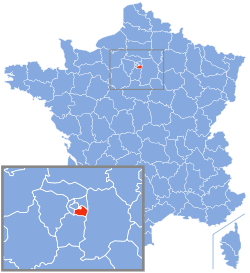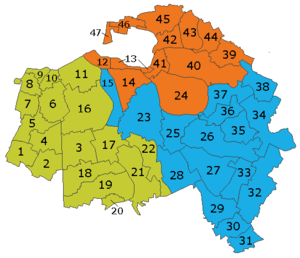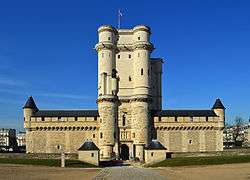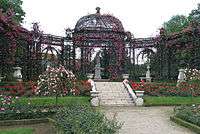Val-de-Marne
Val-de-Marne (French pronunciation: [val də maʁn], "Valley of the Marne") is a French department, named after the Marne River, located in the Île-de-France region. The department is situated to the southeast of the city of Paris and in the Grand Paris.
Val-de-Marne Marne | |
|---|---|
 Prefecture building of the Val-de-Marne department, in Créteil | |
 Location of Val-de-Marne in France | |
| Coordinates: 48°45′N 2°25′E | |
| Country | France |
| Region | Île-de-France |
| Prefecture | Créteil |
| Subprefectures | L'Haÿ-les-Roses Nogent-sur-Marne |
| Government | |
| • President of the General Council | Christian Favier (PCF) |
| Area | |
| • Total | 245 km2 (95 sq mi) |
| Population (2016) | |
| • Total | 1,378,151 |
| • Rank | 11th |
| • Density | 5,600/km2 (15,000/sq mi) |
| Time zone | UTC+1 (CET) |
| • Summer (DST) | UTC+2 (CEST) |
| Department number | 94 |
| Arrondissements | 3 |
| Cantons | 25 |
| Communes | 47 |
| ^1 French Land Register data, which exclude estuaries, and lakes, ponds, and glaciers larger than 1 km2 | |
Geography
Val-de-Marne is, together with Seine-Saint-Denis and Hauts-de-Seine, one of three small departments in Île-de-France that form a ring around Paris, known as the Petite Couronne (i.e. "inner ring"). Since January 1, 2016 Val de Marne is included in Métropole du Grand Paris.

Administration
Val-de-Marne is made up of 3 departmental arrondissements and 47 communes:

History
Val-de-Marne was created in January 1968, through the implementation of a law passed in July 1964. Positioned to the south-east of the Paris ring road (and the line of the old city walls), it was formed from the southern-eastern part of the (previously much larger) Seine department, together with a small portion taken from the broken-up department of Seine-et-Oise.
Demographics
Population development since 1881:
| Year | Pop. | ±% p.a. |
|---|---|---|
| 1881 | 161,607 | — |
| 1891 | 213,706 | +2.83% |
| 1901 | 288,879 | +3.06% |
| 1911 | 386,073 | +2.94% |
| 1921 | 462,200 | +1.82% |
| 1931 | 657,322 | +3.58% |
| 1936 | 685,295 | +0.84% |
| 1946 | 672,024 | −0.20% |
| 1954 | 767,729 | +1.68% |
| 1962 | 974,962 | +3.03% |
| 1968 | 1,121,319 | +2.36% |
| 1975 | 1,215,713 | +1.16% |
| 1982 | 1,193,655 | −0.26% |
| 1990 | 1,215,538 | +0.23% |
| 1999 | 1,227,250 | +0.11% |
| 2006 | 1,298,340 | +0.81% |
| 2011 | 1,333,702 | +0.54% |
| 2016 | 1,378,151 | +0.66% |
| source:[1] | ||
Place of birth of residents
| Born in Metropolitan France | Born outside Metropolitan France | |||
|---|---|---|---|---|
| 79.3% | 20.7% | |||
| Born in Overseas France |
Born in foreign countries with French citizenship at birth1 | EU-15 immigrants2 | Non-EU-15 immigrants | |
| 2.1% | 3.3% | 4.8% | 10.5% | |
| 1 This group is made up largely of former French settlers, such as pieds-noirs in Northwest Africa, followed by former colonial citizens who had French citizenship at birth (such as was often the case for the native elite in French colonies), and to a lesser extent foreign-born children of French expatriates. Note that a foreign country is understood as a country not part of France in 1999, so a person born for example in 1950 in Algeria, when Algeria was an integral part of France, is nonetheless listed as a person born in a foreign country in French statistics. 2 An immigrant is a person born in a foreign country not having French citizenship at birth. Note that an immigrant may have acquired French citizenship since moving to France, but is still considered an immigrant in French statistics. On the other hand, persons born in France with foreign citizenship (the children of immigrants) are not listed as immigrants. | ||||
Politics
Current National Assembly Representatives
Tourism

 Roseraie de L'Haÿ
Roseraie de L'Haÿ- An oddity from the Musée Fragonard d'Alfort
 Vincennes Racecourse
Vincennes Racecourse- Paris Zoological Park (formerly Vincennes Zoo)
References
External links
- (in French) Prefecture
- (in French) Departemental Council
- (in French) Citizen Blog